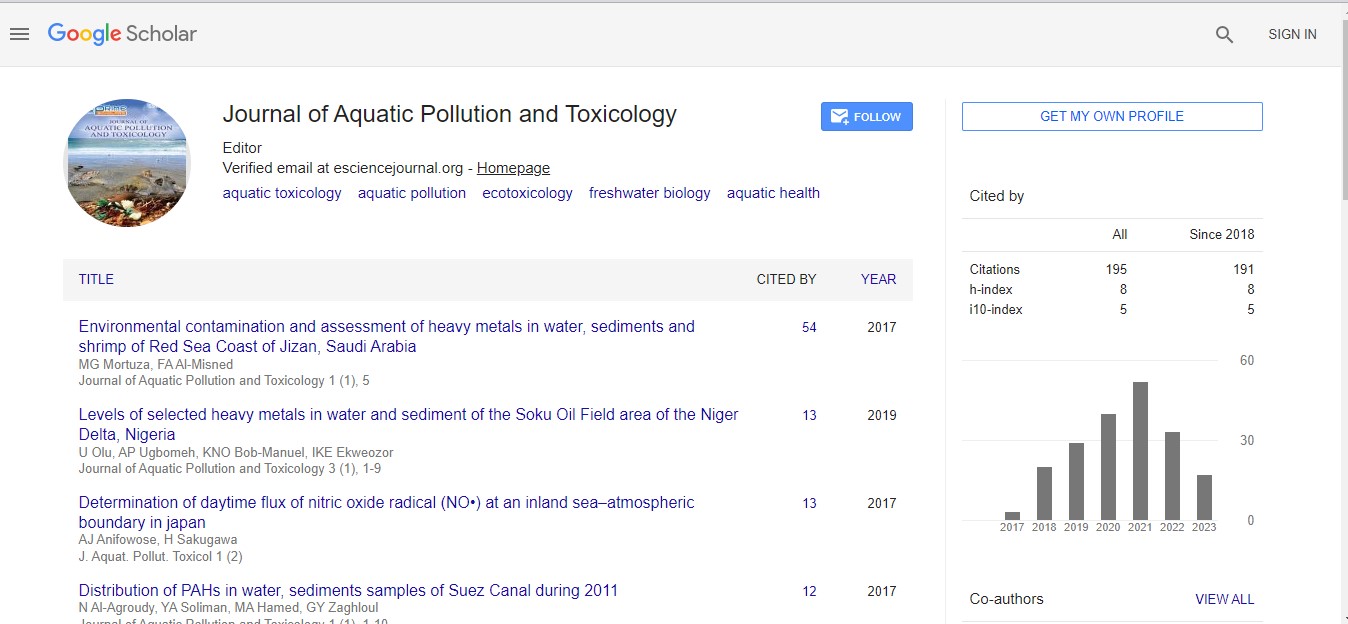Perspective - (2023) Volume 7, Issue 1
Role of Nanostructured Metal Contaminants in Changing Water Salinity and their Participation in Causing Water Pollution
Jeff Sparrow*
Department of Environmental Science, University of Blackwater, USA
*Correspondence:
Jeff Sparrow,
Department of Environmental Science, University of Blackwater,
USA,
Email:
Received: 02-Jan-2023, Manuscript No. IPJAPT-23-16240;
Editor assigned: 04-Jan-2023, Pre QC No. IPJAPT-23-16240 (PQ);
Reviewed: 18-Jan-2023, QC No. IPJAPT-23-16240;
Revised: 23-Jan-2023, Manuscript No. IPJAPT-23-16240 (R);
Published:
30-Jan-2023, DOI: 10.21767/2581-804X-7.1.7
Introduction
Good metal nanostructures stand apart in light of the improvement
of nanotechnology and their capacity to genuinely commit
to the fields of harmless to the ecosystem power, plasmonics,
catalysis and photocatalysis. Accordingly, their headway systems
have been improved to convey nanostructures with controlled
shape, size, and estimation that help various applications. Metallic
nanoparticles have gotten a great deal of thought in both
assessment and current applications. AgNPs have attracted interest
due to their striking optical, electronic, and reactant properties.
Different physical and manufactured cycles can be used to
make AgNPs, yet this can be trying a result of high energy usage,
appearance of noxious and risky engineered compounds, use
of marvelous equipment, and mix conditions may influence the
environment. On account of the creating consideration regarding
the awkward effects of designed procedures on the environment,
including green science as a choice as opposed to ordinary
techniques is reliably appealing.
Description
Factors have been represented to self-coordinate AgNPs without
the necessity for additional stabilizers or diminishing trained
professionals. The plant-based methodology for consolidating
his AgNPs is advantageous over the microbial strategy since it is
less harmful to the body, more versatile, and needn’t bother with
help of cell social orders. They are used in the one-step lessening
of regular poisons nitroaromatics to make aminoaromatics.
The blend of aminoaromatics from nitroaromatics is of phenomenal
interest. This is in light of the fact that aminoaromatic
compounds are huge design blocks for the mix of herbicides,
colors, malignant growth counteraction specialists, medications,
polymers and other fine manufactured substances. Synergist
Hydrogenation of Nitroaromatics Using Iron, Tin, Zinc, Au/SiO2,
Au/Al2O3, Pd/TiO2, Pt-Ne Bimetallic Nanoparticles, and Pt/TiO2 Works with Aminoaromatics can. These strategies have drawbacks:
The prerequisite for hazardous solvents, strong decreasing
trained professionals, and exorbitant metals like Pt, Au, Pd,
heat, high pressures, and time of risky outcomes. Nevertheless,
the procedure for diminishing fragrant nitro strengthens using
AgNPs is limitlessly better to these various strategies since it is
prudent, non-harmful, makes no horrendous aftereffects, and
requires simply encompassing temperature and strain. Awesome
for Unsafe and steady regular defilements, known as p-nitrophenols,
explicitly, have caused unpreventable stress over their troublesome
effects on human prosperity.
Conclusion
It causes tainting of surface water and groundwater. This dirties
water (surface water and groundwater). Since p-aminophenol (p-
AP) is a compound with a low level of destructiveness, the change
of p-nitrophenol to p-aminophenol has transformed into a critical
issue. In this continuous audit, Trigonella foenum-graceum L.
leaf removes were used to upgrade the reaction conditions like
extraction volume, gathering of silver nitrate, temperature, pH
of the reaction medium, and agonizing opportunity to achieve
nano-sized silver. Particles (AgNPs) were mixed. The organized
nanoparticles were depicted using UV-Vis spectroscopy, field-release
sifting electron microscopy, atom size analyzer, X-bar diffraction,
significant standard transmission electron microscopy,
and Fourier change infrared spectroscopy. The synergist development
of AgNPs for the diminishing of regular tainting p-nitrophenol
to p-aminophenol was investigated. Silver nanoparticles
were integrated using Trigonella foenum-graecum L. leaf isolated,
which went probably as both reducing and covering subject
matter experts. Different reaction conditions, for instance, leaf
eliminate aggregate, AgNO3 obsession, reaction medium pH,
temperature and agonizing time were improved for the mix of
AgNPs. These AgNPs were also used as forces in the change of
p-nitrophenol to p-aminophenol.
Citation: Sparrow J (2023) Role of Nanostructured Metal Contaminants in Changing Water Salinity and their Participation in causing
Water Pollution. J Aquat Pollut Toxicol. 7:7.
Copyright: © 2023 Sparrow J. This is an open-access article distributed under the terms of the Creative Commons Attribution
License, which permits unrestricted use, distribution, and reproduction in any medium, provided the original author and source
are credited.

